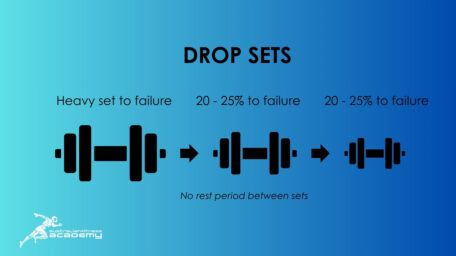WHAT IS A DROP SET?
A drop set is where you take an exercise to failure. You’d pick a weight you can do 8 to 10 reps with. On your 10th rep, you’re basing your last rep before failure, you would immediately reduce the weight by 20 – 25 per cent, so you can get another 3 – 6 reps out at this lower weight. As soon as you hit failure again, drop the weight again. There are a lot of different protocols out there, but generally around 3 drops in weight are the most common. With no rest period between the drops.
DROP SETS VS NORMAL SETS
In terms of incorporating into your exercise regime, some literature on drop sets compares them to what we’ll term straight sets ie 10 reps, 2-3 minutes rest period between 3 to 4 sets of the same weight. The literature found no significant difference in hypertrophy. Both groups saw gains or improvements in muscle mass, so drop sets are an effective way to train. One of the studies found slightly more hypertrophy results in the drop-set group. However, it wasn’t significant, so it didn’t have enough value in terms of statistical analysis to be a significant difference.
DOWNSIDE OF DROP SETS
The negative side of drop sets is an increase in fatigue. Studies show significant differences in RPEs and suggest a correlation inclined to overtraining because of the higher stress put on the neuromuscular system when contrasted to straight sets, where you get to recover between each set. The Julius and Finken-Schoenfeld article mentions the potential for less strength improvement with drop sets. They theorized a slight drop in strength, by testing the 1RM of their participants pre- and post where they saw more improvement in strength with the straight sets over the drop sets.
Essentially the straight sets are doing more sets at a heavier weight, whereas a drop set is only doing one set and the weight gets lighter as they go. So the stimulus of a heavier weight doesn’t get as many reps out of a heavier weight. But if you’re looking to build both size and strength, drop sets may not be as good as your normal straight sets with sets, reps and reps.
POSITIVE SIDE OF DROP SETS
If you’re time-poor or you’re trying to get gym sessions done quickly, drop sets can be useful. The group that was doing the drop set protocol was finished within half to a third of the time that it took the other group to complete the straight sets workout. So you get the same hypertrophy result, but in half the time, potentially even a third of the time.
HOW TO INCORPORATE DROPSETS INTO YOUR WORKOUT
Drop sets are good if you manage fatigue and workload – because if you’re doing drop sets every session, fatigue and recovery may be negatively impacted. In which case you will not see that maximal hypertrophy result -and will be more prone to injury.
Leave straight sets for compound lifts, and larger muscles. Then drop sets for the smaller muscle groups ie instead of doing three sets of bicep curls at the end of your session, one quick drop set of biceps will stimulate muscle growth and instead of taking 15 minutes you can get it done in three to five minutes. Look at programming drop sets in every four weeks, at the end of the fourth week of your block. With a focus on isolation exercises where you can go to failure, and not compromise form.







